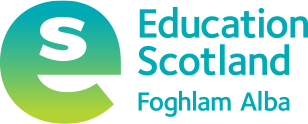Early learning and childcare quality indicators: Leadership of continuous improvement
Leadership of continuous improvement is an HM Inspector quality indicator. There are illustrations of practice and challenge questions below. These can help you to evaluate your current practice and identify areas for growth.
Themes for leadership of continuous improvement
The themes for this quality indicator are:
- pedagogical leadership
- leadership and professional learning
- planning and continuous improvement
About this quality indicator
This quality indicator relates to leadership of improvements that are ambitious and reflect the views and aspirations of all stakeholders. These build upon a shared vision and values. It highlights the importance of strong strategic guidance and direction to ensure early years pedagogy and practice are of the highest quality.
It recognises the importance of high-quality professional learning and using evidence-based research to inform practice. It highlights the impact of effective leadership at all levels which improves pedagogy, educational outcomes and equity for all.
This quality indicator reflects the expectation that leaders use robust self-evaluation to plan and implement well-paced, sustainable change to improve outcomes for all children.
'Very good' pedagogical leadership
Senior leaders are visible and provide strong strategic guidance and direction. They support all staff to provide high-quality learning and teaching to secure children’s progress. Senior leaders promote and support innovation, creativity and professional enquiry. They enable staff to be highly effective leaders of learning.
There is a strong focus on improving wellbeing and educational outcomes for children. Staff demonstrate a determination to recognise, respect and promote children’s rights. This reduces inequity, challenges discrimination and improves outcomes for all. We actively use local and national guidance and evidence-based research about how children learn. This informs our pedagogy and all aspects of our practice.
We have a shared understanding of pedagogy and how this enables the implementation of the curriculum. Senior leaders monitor the quality of interactions, experiences and spaces and provide meaningful feedback to staff to ensure continuous improvement.
‘Weak’ pedagogical leadership
Our lack of strong pedagogical leadership, strategic direction and effective monitoring has a significant impact on the quality of children’s learning experiences. Our interactions, experiences and the learning environment are not improving consistently, and there is insufficient focus on pedagogy that secures children’s progress.
Our guidance and feedback to improve practice is limited or inconsistent. As a result, our weaknesses persist, and the overall quality of education remains variable or low.
'Very good' leadership and professional learning
Through highly effective leadership at all levels, we consistently achieve high standards. We motivate, support, and inspire others to improve their pedagogy and practice continually. Across our team, there is a strong ethos of valuing professional learning, development and collaborative working to build capacity and sustain highly effective practice.
We engage in a broad range of professional learning that enables us to remain knowledgeable, skilled and up to date in our practice. We use professional learning and development opportunities very well to influence and support pedagogy, practice and improvement priorities to improve outcomes for all children, with a strong focus on equity and inclusion.
‘Weak’ leadership and professional learning
Our professional learning is not consistently well planned, well used, or aligned to the needs of the setting. Development opportunities are not leading to measurable improvements in pedagogy or outcomes for children.
We have limited evidence of valuing continuous learning or supporting the development of shared understanding and confidence in practice. This weakens our collective capacity to improve quality or address areas of development.
'Very good' planning and continuous improvement
Our clear co-created vision and values reflect the ambitions of staff, children, stakeholders and the community. They underpin the setting’s ethos and context, which reflects very well the needs of children and families and improvement work.
Ongoing critical reflection and robust self-evaluation involves all staff, children and stakeholders. This leads to clear plans for improvement with specific, measurable targets to support the implementation of well-informed change.
Senior leaders guide and manage the direction and pace of change very successfully. Highly effective strategies are used to monitor and evaluate the impact of change, drawing on a range of evidence, including self-evaluation and inform future actions. All those involved with the setting are clear about improvements and the positive impact on the quality of ELC provided.
‘Weak’ planning and continuous improvement
Our self-evaluation is not robust or well used to inform improvement planning. We do not have a shared or rigorous understanding of our strengths and areas for development.
Our collaboration and consultation with staff, children, and stakeholders is limited and does not lead to meaningful or evidence-informed decisions.
Self-evaluation evidence is not used effectively to identify priorities, pace change, or evaluate impact. As a result, our improvement is slow or not sustained. These weaknesses are having a negative impact on children’s outcomes and the overall quality of early learning and childcare provided.
The following challenge questions can support your self-evaluation:
-
How well do we use evidence-based research, local and national guidance to inform our pedagogy, practice and improvements?
-
How well do we support one another, share practice and take responsibility for leading improvements?
-
In what ways do we use robust self-evaluation to make decisions about professional learning and improvement?
-
In what ways do senior leaders role model and influence high-quality practice?
-
How well and in what ways does monitoring of the quality of the early learning and childcare (ELC) we provide influence change and improvement?
-
To what extent does professional learning influence changes to our practice that impact positively on outcomes for children? How do we know?
-
In what ways do we support children, staff and stakeholders to share their views, experiences and opinions? To what extent do their views influence change?
-
How effectively do we engage others to develop a shared vision and purpose for our setting?
-
How well do our vision and values underpin the work of the setting? What impact do they have on improving the quality of ELC we provide?
